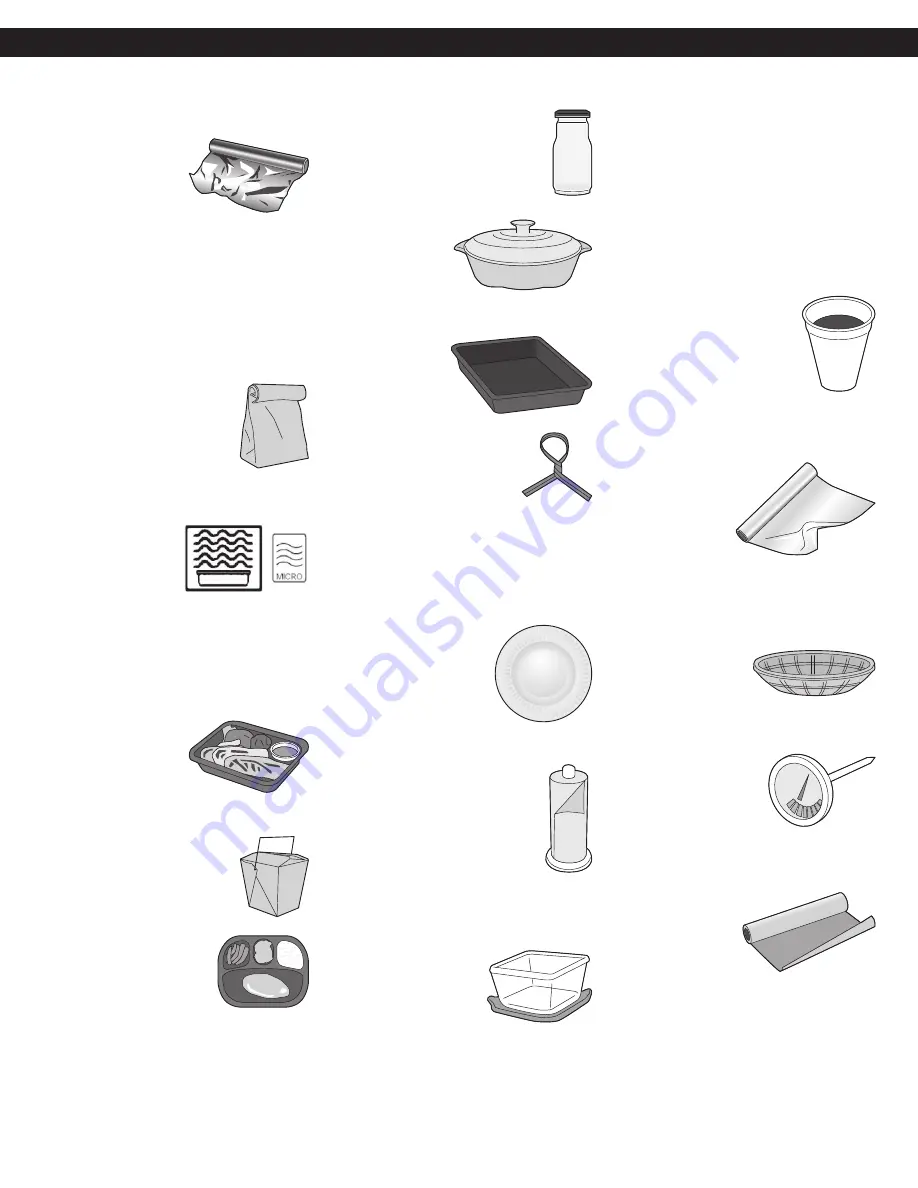
6
Cookware Guide
This section answers the question, “Can I use in the Microwave?”
Aluminum Foil
It is not
recommended to
use. Arcing can
occur if foil is too
close to oven wall
or door and cause
damage to your
oven.
Browning Dish
Yes. Only use browning dishes that are
designed for microwave cooking. Check
browning dish information for
instructions/heating chart. Do not
preheat for more than six minutes.
Brown Paper Bags
No. They may cause a fire
in the oven.
Microwave Safe
Yes. If labeled Microwave Safe, check
manufacturers’ directions for use in
microwave heating.
Some dinnerware
may state on the
back of the dish,
“Oven-Microwave
Safe”.
Dinnerware
If unlabeled, use
CONTAINER TEST
below.
Disposable Polyester Paperboard
Dishes
Yes. Some frozen
foods are packaged
in these dishes.
Also can be
purchased in some
grocery stores.
Fast Food Cartons with
Metal Handle
No. Metal handle may
cause arcing.
Frozen Dinner Trays
If made for the
microwave, then yes. If it
contains metal, then no.
Glass Jars
No. Most glass jars are not heat
resistant.
Heat Resistant Oven
Glassware/Ceramic
Yes, but only
ones for
microwave
cooking and
browning.
(See
CONTAINER TEST
below.)
Metal Bakeware
No. Metal can
cause arcing
and damage to
your oven.
Metal Twist-Ties
No. May cause arcing which
could cause a fire in the oven.
Oven Cooking Bag
Yes. Follow manufacturers’ directions.
Close bag with the nylon tie provided, a
strip cut from the end of the bag, or a
piece of cotton string. Do not close with
metal twist-tie. Make six
1
⁄2-inch slits
near the closure.
Paper Plates/Cups
Yes. Use to warm
cooked foods, and to
cook foods that require
short cooking time,
such as hot dogs.
Do
not microwave paper cups; they may
overheat and ignite.
Towels & Napkins
Yes, only paper napkins/towels.
Use to warm rolls and
sandwiches, only if labeled safe
for microwave use. Do NOT
use recycled paper towels.
Parchment Paper
Yes. Use as a cover to prevent splattering.
Plastic Cookware
Yes, with caution.
Should be labeled,
“Suitable for
Microwave Heating.”
Check Microwave Safe manufacturers’
directions for recommended uses. Some
microwave safe plastic containers are
not suitable for cooking foods with high
fat or sugar content. The heat from hot
food may cause warping.
Plastic, Melamine
No. This material absorbs microwave
energy. Dishes get HOT!
Plastic Foam Cups
Yes, with caution. Plastic
foam will melt if foods
reach a high temperature.
Use short term only to
reheat foods to a low
serving temperature.
Do
not microwave paper cups; they may
overheat and ignite.
Plastic Wrap
Yes. Use to cover
food during
cooking to retain
moisture and
prevent
splattering.
Should be labeled “Suitable for Microwave
Heating”. Check package directions.
Straw, Wicker, Wood
Yes, short term only.
Use only for short
term reheating and
to bring food to a
low serving temperature. Wood may dry
out, split or crack.
Thermometers
Only microwave safe
thermometers can be
used, NOT
conventional
thermometers.
Wax Paper
Yes. Use as a
cover to prevent
splattering and to
retain moisture.
CONTAINER TEST
TO TEST A CONTAINER FOR SAFE MICROWAVE OVEN USE:
Fill a microwave safe cup with cool water and place it in the
microwave oven along side the empty container to be tested;
heat one (1) minute at P 10 (HIGH)
. If the container is
microwave oven safe (transparent to microwave energy), the empty container should remain comfortably cool and the water
should be hot. If the container is hot, it has absorbed some microwave energy and should NOT be used. This test cannot be
used for plastic containers.
Summary of Contents for NN-SU65LS
Page 2: ......








































